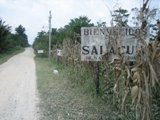
We got to San Juan in the afternoon and were able to witness some of the landslide devastation caused by Hurricane Stan late last year. Unbelivable. We spent the night in San Juan and attended lectures on waste management and developing groups within the community we will be assigned to. Early the next morning, the two groups,ecotourism and environmental education, split up and went their separate ways for the next two days.

Corby's group (ecotourism) stayed in San Juan for another night and took a tour of the town, where they visited the site of Maximon (a Guatemalan Saint worshiped by many people here, but not acknowledged by the Catholic church) and also came upon a Pre-Columbian artifact in the middle of a coffee field. Their group was also able to take a swim in Lake Atitlan, which some consider the most beautiful lake in the world. The following day the group went to a park to help build trails up to a zip-line. The reward afterwards was being able to ride the longest zip-line in Central America. It sounds like the ecotourism group has more fun!??

Meanwhile, Kari's group (environmental education) took a ferry over to the other side of Lake Atitlan to a pueblo called Santiago. They visited a couple schools that other volunteers are working in and held a recycled art workshop with the kids. Much of the next two days were spent in the school system, teaching and observing.

On Thursday afternoon, the two groups met back at Corazon del Bosque and spent time watching the ecotourism group give presentations to workers at the park on solid waste management. During the evening we had a cultural exchange night with the Guatemaltecos and a big bonfire to end the night. The following morning we headed back to Santo Tomas, but not before Corby got some birdwatching in with the rest of the group. For those of you interested in birding- they spotted a Collared Trogon, an endemic species to Guatemala. It's nice to be back "home" again after a week of traveling. The upcoming week is filled with more classes at the training center and an eco-camp that we will be hosting at the end of the week.






